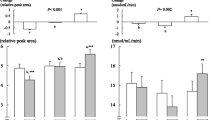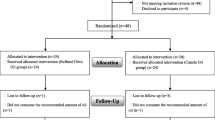Abstract
Purpose
Lipoprotein associated phospholipase A2 (Lp-PLA2) is a novel inflammatory factor that has been independently associated with stroke and cardiovascular disease (CVD). Omega-3 fats have been implicated in reducing inflammation associated with CVD. The aim of this study was to determine if an 8-week isocaloric diet supplemented with eicosapentaenoic acid (EPA) and docosahexaenoic (DHA) in the form of fish oil or α-linolenic acid (ALA) in the form of flaxseed oil would alter Lp-PLA2 among healthy adults ages 50 years and older.
Methods
Fifty-nine healthy adults (~75% female, average age 61 years) were randomized to one of three groups with equal amounts of total fat intake. All capsules contained ~1 g of fat. The control group (n = 19) consumed olive oil capsules (~11 g/day); the ALA group (n = 20) consumed flaxseed oil capsules (~11 g/day) and the EPA/DHA group (n = 20) consumed fish oil capsules (~2 g/day + 9 g/day of olive oil). Fasting blood samples were obtained before and after the 8-week intervention for determination of Lp-PLA2 mass and activity as well as lipid values.
Results
We did not find any significant changes in Lp-PLA2 mass or activity after the intervention in any of the groups; however, change in oxidized LDL was associated with change in Lp-PLA2 mass (r = 0.37, p < 0.01).
Conclusion
Supplementing the diet with omega-3 fatty acids for 8-weeks did not influence Lp-PLA2 activity or mass among older adults; altering oxidized LDL may be necessary to see changes in Lp-PLA2 levels.
Similar content being viewed by others
References
Young J, Libby P, Schonbeck U (2002) Cytokines in the pathogensis of atherosclerosis. Thromb Haemost 88:554–567
Macphee CH, Nelson J, Zalewski A (2006) Role of lipoprotein-associated phospholipase A2 in atherosclerosis and its potential as a therapeutic target. Curr Opin Pharmacol 6:154–161
Zalewski A, Macphee C, Nelson JJ (2005) Lipoprotein-associated phospholipase A2: a potential therapeutic target for atherosclerosis. Curr Drug Targets Cardiovasc Haematol Disord 5:527–532
Yang EH, McConnell JP, Lennon RJ et al (2006) Lipoprotein-associated phospholipase A2 is an independent marker for coronary endothelial dysfunction in humans. Arterioscler Thromb Vasc Biol 26:106–111
Oei HH, van der Meer IM, Hofman A et al (2005) Lipoprotein-associated phospholipase A2 activity is associated with risk of coronary heart disease and ischemic stroke: the Rotterdam Study. Circulation 111:570–575
Koenig W, Khuseyinova N, Lowel H, Trischler G, Meisinger C (2004) Lipoprotein-associated phospholipase A2 adds to risk prediction of incident coronary events by C-reactive protein in apparently healthy middle-aged men from the general population: results from the 14-year follow-up of a large cohort from southern Germany. Circulation 110:1903–1908
Ballantyne CM, Hoogeveen RC, Bang H et al (2005) Lipoprotein-associated phospholipase A2, high-sensitivity C-reactive protein, and risk for incident ischemic stroke in middle-aged men and women in the Atherosclerosis Risk in Communities (ARIC) study. Arch Intern Med 165:2479–2484
Sudhir K (2005) Clinical review: lipoprotein-associated phospholipase A2, a novel inflammatory biomarker and independent risk predictor for cardiovascular disease. J Clin Endocrinol Metab 90:3100–3105
Winkler K, Winkelmann BR, Scharnagl H et al (2005) Platelet-activating factor acetylhydrolase activity indicates angiographic coronary artery disease independently of systemic inflammation and other risk factors: the Ludwigshafen Risk and Cardiovascular Health Study. Circulation 111:980–987
Caslake MJ, Packard CJ, Suckling KE, Holmes SD, Chamberlain P, Macphee CH (2000) Lipoprotein-associated phospholipase A(2), platelet-activating factor acetylhydrolase: a potential new risk factor for coronary artery disease. Atherosclerosis 150:413–419
Iribarren C, Gross MD, Darbinian JA, Jacobs DR Jr, Sidney S, Loria CM (2005) Association of lipoprotein-associated phospholipase A2 mass and activity with calcified coronary plaque in young adults: the CARDIA study. Arterioscler Thromb Vasc Biol 25:216–221
Weintraub H (2008) Identifying the vulnerable patient with rupture-prone plaque. Am J Cardiol 101:3f–10f
James M, Gibson RA, Cleland LG (2000) Dietary polyunsaturated fatty acids and inflammatory mediator production. Am J Clin Nutr 71:343S–348S
Caughey GE, Mantzioris E, Gibson RA, Cleland LG, James MJ (1996) The effect on human tumor necrosis factor alpha and interleukin 1 beta production of diets enriched in n-3 fatty acids from vegetable oil or fish oil. Am J Clin Nutr 63:116–122
Rallidis LS, Paschos G, Liakos GK, Velissaridou AH, Anastasiadis G, Zampelas A (2003) Dietary alpha-linolenic acid decreases C-reactive protein, serum amyloid A and interleukin-6 in dyslipidaemic patients. Atherosclerosis 167:237–242
Bemelmans WJ, Lefrandt JD, Feskens EJ et al (2004) Increased alpha-linolenic acid intake lowers C-reactive protein, but has no effect on markers of atherosclerosis. Eur J Clin Nutr 58:1083–1089
Calder PC (2003) N-3 polyunsaturated fatty acids and inflammation: from molecular biology to the clinic. Lipids 38:343–352
Macphee CH, Nelson JJ (2005) An evolving story of lipoprotein-associated phospholipase A2 in atherosclerosis and cardiovascular risk prediction. Eur Heart J 26:107–109
Emken EA, Adlof RO, Gulley RM (1994) Dietary linoleic acid influences desaturation and acylation of deuterium-labeled linoleic and linolenic acids in young adult males. Biochim Biophys Acta 1213:277–288
Friedewald WT, Levy RI, Fredrickson DS (1972) Estimation of the concentration of low-density lipoprotein cholesterol in plasma, without use of the preparative ultracentrifuge. Clin Chem 18:499–502
Mantzioris E, James MJ, Gibson RA, Cleland LG (1994) Dietary substitution with alpha-linolenic acid-rich vegetable oil increases eicosapentoaenoic acid concentrations in tissues. Am J Clin Nutr 59:1304–1309
Mantzioris E, James MJ, Gibson RA, Cleland LG (1995) Differences exist in the relationships between dietary linoleic and alpha-linolenic acids and the respective long-chain metabolites. Am J Clin Nutr 61:320–324
Holvoet P, Vanhaecke J, Janssens S, Van de Werf F, Collen D (1998) Oxidized LDL and malondialdehyde-modified LDL in patients with acute coronary syndromes and stable coronary artery disease. Circulation 98:1487–1494
Holvoet P, Martens A, Verhamme P, Bogaerts K, Beyens G, Verhaeghe R, Collen D, Muls E, de Werf F (2001) Circulating oxidized LDL is a useful marker for identifying patients with coronary artery disease. Arterioscler Thromb Vasc Biol 21:844–848
Holvoet P, Satssen JM, Van Cleemput J, Collen D, Vanhaecke J (1998) Oxidized low density lipoproteins in patients with transplant- associated coronary artery disease. Arterioscler Thromb Vasc Biol 18:100–107
Pedersen MW, Koenig W, Christensen JH, Schmidt EB (2009) The effect of marine n-3 fatty acids in different doses on plasma concentrations of Lp-PLA2 in healthy adults. Eur J Nutr 48:1–5
Schmidt EB, Koenig W, Khuseyinova N, Christensen JH (2008) Lipoprotein-associated phospholipase A2 concentrations in plasma are associated with the extent of coronary artery disease and correlate to adipose tissue levels of marine n-3 fatty acids. Atherosclerosis 196:420–424
Eslick G, Howe PRC, Smith C, Priest R, Bensoussan A (2009) Benefits of fish oil supplementation in hyperlipidemia: a systematic review and meta-analysis. In J of Cardiology 136:4–16
Vickers K, Maguire CT, Wolfert R, Burns AR, Reardon M, Geis R, Holvoet P, Morrisett JD (2009) Relationship of lipoprotein-associated phospholipase A2 and oxidized low-density lipoprotein in carotid atherosclerosis. J Lipid Res 50:1735–1743
Oldgren J, James SK, Siegbahn A, Wallentin L (2007) Lipoprotein-associated phospholipase A2 does not predict mortality or new ischaemic events in acute coronary syndrome patients. Eur Heart J 28:699–704
Wootton PT, Stephens JW, Hurel SJ et al (2006) Lp-PLA2 activity and PLA2G7 A379 V genotype in patients with diabetes mellitus. Atherosclerosis 189:149–156
Persson M, Nilsson JA, Nelson JJ, Hedblad B, Berglund G (2006) The epidemiology of Lp-PLA2: distribution and correlation with cardiovascular risk factors in a population-based cohort. Atherosclerosis 190:388–396
Albert MA, Glynn RJ, Wolfert RL, Ridker PM (2005) The effect of statin therapy on lipoprotein associated phospholipase A2 levels. Atherosclerosis 182:193–198
Schaefer E, McNamara JR, Asztalos BF, Tayler T, Daly JA, Gleason JL, Seman LJ, Ferrari A, Rubenstein JJ (2005) Effects of atorvastatin versus other statins on fasting and postprandial c-reactive protein and lipoprotein-associated phospholipase A2 in patients with coronary heart disease versus control subjects. Am J Cardiol 95:1025–1032
Winkler K, Abletshauser C, Friedrich I, Hoffmann MM, Wieland H, Marz W (2004) Fluvastatin slow-release lowers platelet-activating factor acetyl hydrolase activity: a placebo-controlled trial in patients with type 2 diabetes. J Clin Endocrinol Metab 89:1153–1159
Acknowledgments
This work was funded by a grant from the United States Department of Agriculture-Agriculture Experiment Station at Colorado State University. We would like to thank Robert Wolfert and diaDexus, Inc. for their support in performing the Lp-PLA2 assays.
Author information
Authors and Affiliations
Corresponding author
Rights and permissions
About this article
Cite this article
Nelson, T.L., Hokanson, J.E. & Hickey, M.S. Omega-3 fatty acids and lipoprotein associated phospholipase A2 in healthy older adult males and females. Eur J Nutr 50, 185–193 (2011). https://doi.org/10.1007/s00394-010-0126-7
Received:
Accepted:
Published:
Issue Date:
DOI: https://doi.org/10.1007/s00394-010-0126-7




